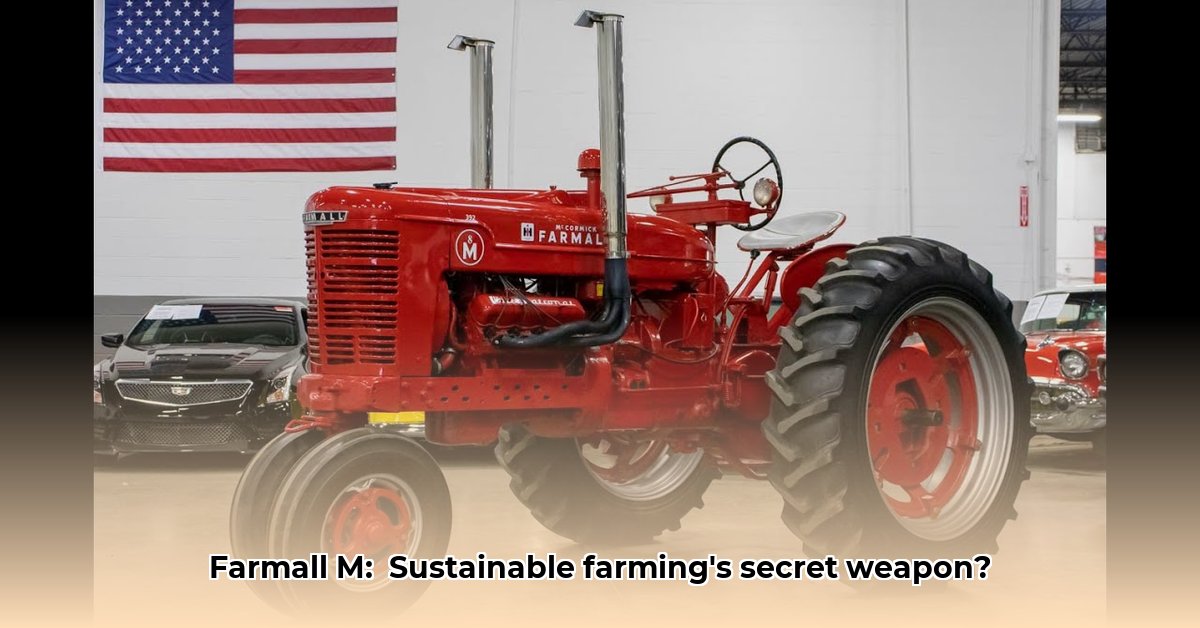
The Farmall M tractor, a legend in its time, wasn't engineered with modern sustainability in mind. Born from a post-war world focused on rapid, affordable production, its legacy offers surprising insights for today's environmentally conscious farmers. This isn't just a historical artifact; it's a powerful case study in how seemingly simple design choices can have profound, long-lasting consequences. For more information on Farmall tractors, check out this useful resource.
A Simple Machine, Lasting Impact
The Farmall M's design emphasized practicality. Its straightforward mechanics made maintenance and repair relatively easy for farmers, often requiring only basic tools and skill. This adaptability extended to its use with a variety of crops, eliminating the need for specialized machinery. Furthermore, its compatibility with both gasoline and diesel fuel offered considerable flexibility concerning fuel choice and availability. While its designers likely didn't fully foresee the long-term implications of these choices on fuel efficiency and the environment, the Farmall M's impact on sustainability is undeniable. It stands as a compelling example of how simple, well-considered solutions can have far-reaching positive consequences.
Then and Now: A Look at Design Evolution
The open operator station, characteristic of its era, contrasts sharply with today's safety-focused designs. This open design, while providing excellent visibility, also exposed the operator to weather extremes, dust, and exhaust fumes. This difference highlights the evolution of farm equipment towards optimizing operator well-being. We now recognize that a healthy, comfortable operator is essential to both efficiency and the long-term sustainability of agricultural practices.
Similarly, the manual steering and mechanical brakes differed significantly from the power steering and hydraulic brakes found in modern tractors. This design evolution underscores the growing awareness of operator comfort and ergonomics and their direct impact on sustainable farming. Reduced operator strain means increased efficiency and a reduced risk of injury. Isn't it striking how this evolution directly reflects the pursuit of sustainable agricultural practices?
Fuel Choices: A Look Back, A Look Ahead
The Farmall M's ability to run on either gasoline or diesel fuel reflects the early stages of fuel consideration in agriculture. Cost and availability were the primary concerns at the time. However, this seemingly straightforward economic decision resonates strongly with today's focus on fuel efficiency and the urgent need for cleaner energy sources. The Farmall M serves as a poignant reminder of how seemingly simple choices from the past can have significant implications for modern environmental responsibility.
Durability and Longevity: Lessons from the Past
While precise data on the Farmall M's full environmental footprint remains elusive, some aspects are clear. Its sturdy, robust construction emphasizes a philosophy of durability that merits attention today. Unlike modern machines often designed for shorter lifespans and planned obsolescence, the Farmall M was built to last, emphasizing repairability and longevity. Could we learn from this emphasis on resilient machinery? Many agricultural experts believe that building longer-lasting, more easily repairable equipment is vital to environmental sustainability.
From Humble Beginnings to Modern Marvels
The Farmall M's legacy extends far beyond its direct environmental impact. It marked a significant step forward in agricultural mechanization. The remarkable journey from this relatively simple machine to today's sophisticated agricultural technology underscores a continuous drive towards increased efficiency and environmental consciousness. The emergence of precision agriculture, focused on optimized yields and resource reduction, is a direct outcome of this evolution, born from the early pursuit of efficiency embodied by the Farmall M.
The Future of Sustainable Farming: Taking Inspiration from the Past
What specific lessons can we glean from the Farmall M about sustainable farming? Let's consider these key insights:
Built to Last: Designing durable, repairable machinery with extended lifespans is crucial for reducing the environmental impact of agriculture's constant cycle of manufacturing, use, and disposal.
Efficiency First: Optimizing every resource—fuel, fertilizer, machine operations—is paramount to minimizing waste and maximizing output.
Operator Health Matters: Prioritizing farmer well-being through safe and comfortable machine design is essential for sustainable agricultural practices.
Fuel Alternatives: The ongoing search for sustainable and renewable energy sources for agricultural machinery remains a top priority in creating a more environmentally friendly future.
The Farmall M serves as more than just a piece of agricultural history. It functions as a potent symbol, a reminder of how the past can inform a sustainable agricultural future. Its simplicity, versatility, and surprisingly relevant sustainability lessons continue to inspire innovation and improvements in modern agricultural methods. The enduring legacy of the Farmall M underscores the valuable lessons that even seemingly "old-fashioned" technology can offer for present-day challenges.